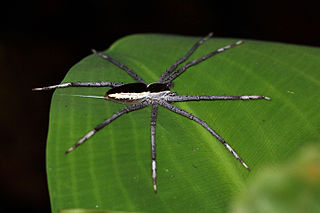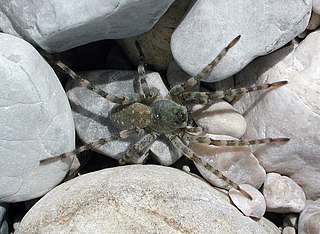
Nursery web spiders (Pisauridae) is a family of araneomorph spiders first described by Eugène Simon in 1890. They resemble wolf spiders (Lycosidae) except for several key differences. Wolf spiders have two very prominent eyes in addition to the other six, while a nursery web spider's eyes are all about the same size. Additionally, female nursery web spiders carry their egg sacs with their jaws and pedipalps instead of attaching them to their spinnerets as wolf spiders do. When the eggs are about to hatch, a female spider builds a nursery "tent", places her egg sac inside, and stands guard outside, hence the family's common name. Like the wolf spiders, however, the nursery web spiders are roaming hunters that don't use webs for catching prey.

Opilio is a genus of harvestmen with more than 60 known species.

Theridion is a genus of tangle-web spiders with almost 600 described species around the world. Notable species are the Hawaiian happy face spider (T. grallator), named for the iconic symbol on its abdomen, and T. nigroannulatum, one of few spider species that lives in social groups, attacking prey en masse to overwhelm them as a team.

Arctosa is a genus of wolf spiders first described by Carl Ludwig Koch in 1847. As of February 2019 it contains 169 species.

Pardosa is a large genus of wolf spiders, with more than 500 described species that are found in all regions of the world.

Phalangium is a genus of harvestmen, that occurs mostly in the Old World. The best known species is Phalangium opilio, which is so common in many temperate regions that it is simply called "harvestman".

The Phalangiidae are a family of harvestmen with about 380 known species. The best known is Phalangium opilio. Dicranopalpus ramosus is an invasive species in Europe.

Rilaena is a genus of the harvestman family Phalangiidae.

The Sclerosomatidae are a family of harvestmen with about 1,300 known species.
Gagrella is a large genus of harvestmen in the family Sclerosomatidae.

Astrobunus is a genus of harvestmen in the family Sclerosomatidae.
Metasclerosoma is a genus of harvestmen in the family Sclerosomatidae.

Lacinius is a genus of harvestmen in the family Phalangiidae.

Odiellus is a genus of harvestmen in the family Phalangiidae.
Egaenus is a genus of harvestmen in the family Phalangiidae.

Metaphalangium cirtanum is a species of harvestman belonging to the family Phalangiidae.

Dasylobus argentatus is a species of harvestman in the family Phalangiidae.
Nemastomatinae is a subfamily of harvestmen with 123 described species in 18 genera.














